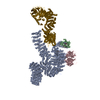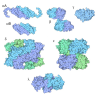+ Open data
Open data
- Basic information
Basic information
| Entry | Database: PDB / ID: 8era | ||||||
|---|---|---|---|---|---|---|---|
| Title | RMC-5552 in complex with mTORC1 and FKBP12 | ||||||
 Components Components |
| ||||||
 Keywords Keywords | COMPLEX (ISOMERASE/KINASE) / Antitumor / mTORC1 / COMPLEX (ISOMERASE-KINASE) complex | ||||||
| Function / homology |  Function and homology information Function and homology informationRNA polymerase III type 2 promoter sequence-specific DNA binding / RNA polymerase III type 1 promoter sequence-specific DNA binding / positive regulation of cytoplasmic translational initiation / regulation of locomotor rhythm / T-helper 1 cell lineage commitment / positive regulation of pentose-phosphate shunt / positive regulation of wound healing, spreading of epidermal cells / TORC2 signaling / TORC2 complex / regulation of membrane permeability ...RNA polymerase III type 2 promoter sequence-specific DNA binding / RNA polymerase III type 1 promoter sequence-specific DNA binding / positive regulation of cytoplasmic translational initiation / regulation of locomotor rhythm / T-helper 1 cell lineage commitment / positive regulation of pentose-phosphate shunt / positive regulation of wound healing, spreading of epidermal cells / TORC2 signaling / TORC2 complex / regulation of membrane permeability / cellular response to leucine starvation / macrolide binding / negative regulation of lysosome organization / heart valve morphogenesis / TFIIIC-class transcription factor complex binding / TORC1 complex / activin receptor binding / voluntary musculoskeletal movement / positive regulation of transcription of nucleolar large rRNA by RNA polymerase I / calcineurin-NFAT signaling cascade / positive regulation of odontoblast differentiation / regulation of osteoclast differentiation / RNA polymerase III type 3 promoter sequence-specific DNA binding / positive regulation of keratinocyte migration / regulation of skeletal muscle contraction by regulation of release of sequestered calcium ion / cytoplasmic side of membrane / transforming growth factor beta receptor binding / regulation of lysosome organization / MTOR signalling / TGFBR1 LBD Mutants in Cancer / Amino acids regulate mTORC1 / cellular response to nutrient / cellular response to L-leucine / energy reserve metabolic process / regulation of autophagosome assembly / Energy dependent regulation of mTOR by LKB1-AMPK / type I transforming growth factor beta receptor binding / TORC1 signaling / negative regulation of activin receptor signaling pathway / ruffle organization / serine/threonine protein kinase complex / heart trabecula formation / cellular response to methionine / negative regulation of cell size / positive regulation of osteoclast differentiation / I-SMAD binding / positive regulation of ubiquitin-dependent protein catabolic process / inositol hexakisphosphate binding / cellular response to osmotic stress / regulation of amyloid precursor protein catabolic process / anoikis / terminal cisterna / negative regulation of protein localization to nucleus / ryanodine receptor complex / signaling receptor inhibitor activity / cardiac muscle cell development / negative regulation of calcineurin-NFAT signaling cascade / regulation of myelination / positive regulation of transcription by RNA polymerase III / 'de novo' protein folding / negative regulation of macroautophagy / ventricular cardiac muscle tissue morphogenesis / Macroautophagy / FK506 binding / positive regulation of myotube differentiation / regulation of cell size / positive regulation of actin filament polymerization / Constitutive Signaling by AKT1 E17K in Cancer / germ cell development / TOR signaling / TGF-beta receptor signaling activates SMADs / behavioral response to pain / mTORC1-mediated signalling / oligodendrocyte differentiation / positive regulation of oligodendrocyte differentiation / regulation of ryanodine-sensitive calcium-release channel activity / positive regulation of translational initiation / Calcineurin activates NFAT / protein kinase activator activity / social behavior / protein serine/threonine kinase inhibitor activity / CD28 dependent PI3K/Akt signaling / positive regulation of TOR signaling / HSF1-dependent transactivation / regulation of macroautophagy / enzyme-substrate adaptor activity / positive regulation of G1/S transition of mitotic cell cycle / response to amino acid / regulation of immune response / 'de novo' pyrimidine nucleobase biosynthetic process / positive regulation of epithelial to mesenchymal transition / heart morphogenesis / vascular endothelial cell response to laminar fluid shear stress / neuronal action potential / positive regulation of lipid biosynthetic process / cellular response to nutrient levels / regulation of cellular response to heat / positive regulation of lamellipodium assembly / cardiac muscle contraction / supramolecular fiber organization Similarity search - Function | ||||||
| Biological species |  Homo sapiens (human) Homo sapiens (human) | ||||||
| Method | ELECTRON MICROSCOPY / single particle reconstruction / cryo EM / Resolution: 2.86 Å | ||||||
 Authors Authors | Tomlinson, A.C.A. / Yano, J.K. | ||||||
| Funding support | 1items
| ||||||
 Citation Citation |  Journal: J Med Chem / Year: 2023 Journal: J Med Chem / Year: 2023Title: Discovery of RMC-5552, a Selective Bi-Steric Inhibitor of mTORC1, for the Treatment of mTORC1-Activated Tumors. Authors: G Leslie Burnett / Yu C Yang / James B Aggen / Jennifer Pitzen / Micah K Gliedt / Chris M Semko / Abby Marquez / James W Evans / Gang Wang / Walter S Won / Aidan C A Tomlinson / Gert Kiss / ...Authors: G Leslie Burnett / Yu C Yang / James B Aggen / Jennifer Pitzen / Micah K Gliedt / Chris M Semko / Abby Marquez / James W Evans / Gang Wang / Walter S Won / Aidan C A Tomlinson / Gert Kiss / Christos Tzitzilonis / Arun P Thottumkara / James Cregg / Kevin T Mellem / Jong S Choi / Julie C Lee / Yongyuan Zhao / Bianca J Lee / Justin G Meyerowitz / John E Knox / Jingjing Jiang / Zhican Wang / David Wildes / Zhengping Wang / Mallika Singh / Jacqueline A M Smith / Adrian L Gill /  Abstract: Hyperactivation of mTOR kinase by mutations in the PI3K/mTOR pathway or by crosstalk with other mutant cancer drivers, such as RAS, is a feature of many tumors. Multiple allosteric inhibitors of ...Hyperactivation of mTOR kinase by mutations in the PI3K/mTOR pathway or by crosstalk with other mutant cancer drivers, such as RAS, is a feature of many tumors. Multiple allosteric inhibitors of mTORC1 and orthosteric dual inhibitors of mTORC1 and mTORC2 have been developed as anticancer drugs, but their clinical utility has been limited. To address these limitations, we have developed a novel class of "bi-steric inhibitors" that interact with both the orthosteric and the allosteric binding sites in order to deepen the inhibition of mTORC1 while also preserving selectivity for mTORC1 over mTORC2. In this report, we describe the discovery and preclinical profile of the development candidate RMC-5552 and the in vivo preclinical tool compound RMC-6272. We also present evidence that selective inhibition of mTORC1 in combination with covalent inhibition of KRAS shows increased antitumor activity in a preclinical model of mutant NSCLC that exhibits resistance to KRAS inhibitor monotherapy. #1:  Journal: Acta Crystallogr D Biol Crystallogr / Year: 2012 Journal: Acta Crystallogr D Biol Crystallogr / Year: 2012Title: Towards automated crystallographic structure refinement with phenix.refine. Authors: Afonine, P.V. / Grosse-Kunstleve, R.W. / Echols, N. / Headd, J.J. / Moriarty, N.W. / Mustyakimov, M. / Terwilliger, T.C. / Urzhumtsev, A. / Zwart, P.H. / Adams, P.D. | ||||||
| History |
|
- Structure visualization
Structure visualization
| Structure viewer | Molecule:  Molmil Molmil Jmol/JSmol Jmol/JSmol |
|---|
- Downloads & links
Downloads & links
- Download
Download
| PDBx/mmCIF format |  8era.cif.gz 8era.cif.gz | 797.5 KB | Display |  PDBx/mmCIF format PDBx/mmCIF format |
|---|---|---|---|---|
| PDB format |  pdb8era.ent.gz pdb8era.ent.gz | 584.2 KB | Display |  PDB format PDB format |
| PDBx/mmJSON format |  8era.json.gz 8era.json.gz | Tree view |  PDBx/mmJSON format PDBx/mmJSON format | |
| Others |  Other downloads Other downloads |
-Validation report
| Summary document |  8era_validation.pdf.gz 8era_validation.pdf.gz | 1.2 MB | Display |  wwPDB validaton report wwPDB validaton report |
|---|---|---|---|---|
| Full document |  8era_full_validation.pdf.gz 8era_full_validation.pdf.gz | 1.3 MB | Display | |
| Data in XML |  8era_validation.xml.gz 8era_validation.xml.gz | 95.2 KB | Display | |
| Data in CIF |  8era_validation.cif.gz 8era_validation.cif.gz | 148 KB | Display | |
| Arichive directory |  https://data.pdbj.org/pub/pdb/validation_reports/er/8era https://data.pdbj.org/pub/pdb/validation_reports/er/8era ftp://data.pdbj.org/pub/pdb/validation_reports/er/8era ftp://data.pdbj.org/pub/pdb/validation_reports/er/8era | HTTPS FTP |
-Related structure data
| Related structure data |  28551MC  8er6C  8er7C M: map data used to model this data C: citing same article ( |
|---|---|
| Similar structure data | Similarity search - Function & homology  F&H Search F&H Search |
- Links
Links
- Assembly
Assembly
| Deposited unit | 
|
|---|---|
| 1 |
|
- Components
Components
-Protein , 4 types, 4 molecules ABCY
| #1: Protein | Mass: 289257.969 Da / Num. of mol.: 1 Source method: isolated from a genetically manipulated source Source: (gene. exp.)  Homo sapiens (human) / Gene: MTOR, FRAP, FRAP1, FRAP2, RAFT1, RAPT1 / Production host: Homo sapiens (human) / Gene: MTOR, FRAP, FRAP1, FRAP2, RAFT1, RAPT1 / Production host:  Homo sapiens (human) Homo sapiens (human)References: UniProt: P42345, non-specific serine/threonine protein kinase |
|---|---|
| #2: Protein | Mass: 11923.586 Da / Num. of mol.: 1 Source method: isolated from a genetically manipulated source Source: (gene. exp.)  Homo sapiens (human) / Gene: FKBP1A, FKBP1, FKBP12 / Production host: Homo sapiens (human) / Gene: FKBP1A, FKBP1, FKBP12 / Production host:  |
| #3: Protein | Mass: 35910.090 Da / Num. of mol.: 1 Source method: isolated from a genetically manipulated source Source: (gene. exp.)  Homo sapiens (human) / Gene: MLST8, GBL, LST8 / Production host: Homo sapiens (human) / Gene: MLST8, GBL, LST8 / Production host:  |
| #4: Protein | Mass: 149200.016 Da / Num. of mol.: 1 Source method: isolated from a genetically manipulated source Source: (gene. exp.)  Homo sapiens (human) / Gene: RPTOR, KIAA1303, RAPTOR / Production host: Homo sapiens (human) / Gene: RPTOR, KIAA1303, RAPTOR / Production host:  Homo sapiens (human) / References: UniProt: Q8N122 Homo sapiens (human) / References: UniProt: Q8N122 |
-Non-polymers , 2 types, 2 molecules 


| #5: Chemical | ChemComp-XZ9 / |
|---|---|
| #6: Chemical | ChemComp-XYU / ( |
-Details
| Has ligand of interest | Y |
|---|
-Experimental details
-Experiment
| Experiment | Method: ELECTRON MICROSCOPY |
|---|---|
| EM experiment | Aggregation state: 2D ARRAY / 3D reconstruction method: single particle reconstruction |
- Sample preparation
Sample preparation
| Component | Name: RMC-5552-mTORC1-FKBP12 / Type: COMPLEX / Entity ID: #1-#4 / Source: RECOMBINANT |
|---|---|
| Source (natural) | Organism:  Homo sapiens (human) Homo sapiens (human) |
| Source (recombinant) | Organism:  Homo sapiens (human) Homo sapiens (human) |
| Buffer solution | pH: 8 |
| Specimen | Conc.: 5 mg/ml / Embedding applied: NO / Shadowing applied: NO / Staining applied: NO / Vitrification applied: YES |
| Vitrification | Cryogen name: ETHANE |
- Electron microscopy imaging
Electron microscopy imaging
| Experimental equipment |  Model: Titan Krios / Image courtesy: FEI Company |
|---|---|
| Microscopy | Model: FEI TITAN KRIOS |
| Electron gun | Electron source:  FIELD EMISSION GUN / Accelerating voltage: 200 kV / Illumination mode: SPOT SCAN FIELD EMISSION GUN / Accelerating voltage: 200 kV / Illumination mode: SPOT SCAN |
| Electron lens | Mode: BRIGHT FIELD / Nominal defocus max: 3000 nm / Nominal defocus min: 1000 nm |
| Image recording | Electron dose: 30 e/Å2 / Film or detector model: GATAN K2 SUMMIT (4k x 4k) |
- Processing
Processing
| Software |
| ||||||||||||||||||||||||
|---|---|---|---|---|---|---|---|---|---|---|---|---|---|---|---|---|---|---|---|---|---|---|---|---|---|
| CTF correction | Type: NONE | ||||||||||||||||||||||||
| 3D reconstruction | Resolution: 2.86 Å / Resolution method: FSC 0.143 CUT-OFF / Num. of particles: 805027 / Symmetry type: POINT | ||||||||||||||||||||||||
| Refinement | Cross valid method: NONE | ||||||||||||||||||||||||
| Refine LS restraints |
|
 Movie
Movie Controller
Controller



 PDBj
PDBj















